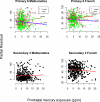Fish consumption, mercury exposure, and their associations with scholastic achievement in the Seychelles Child Development Study
- PMID: 20576509
- PMCID: PMC2934742
- DOI: 10.1016/j.neuro.2010.05.010
Fish consumption, mercury exposure, and their associations with scholastic achievement in the Seychelles Child Development Study
Abstract
Studies of neurodevelopmental outcomes in offspring exposed to MeHg from maternal consumption of fish have primarily measured cognitive abilities. Reported associations have been subtle and in both adverse and beneficial directions. Changes in functional outcomes such as school achievement and behavior in exposed children and adolescents have not been examined. We undertook an assessment of school success of children in the Seychelles Child Development Study (SCDS) main cohort to determine if there were any associations with either prenatal or recent postnatal MeHg exposure. The primary endpoints were Seychelles nationally standardized end-of-year examinations given when the cohort children were 9 and 17 years of age. A subgroup (n=215) from the main cohort was also examined at 9 years of age using a regional achievement test called SACMEQ. Prenatal MeHg exposure was 6.8 ppm in maternal hair; recent postnatal exposure was 6.09 ppm at 9 years and 8.0 ppm at 17 years, measured in child hair. Multiple linear regression analyses showed no pattern of associations between prenatal or postnatal exposure, and either the 9- or 17-year end-of-year examination scores. For the subgroup of 215 subjects who participated in the SACMEQ test, there were significant adverse associations between examination scores and postnatal exposure, but only for males. The average postnatal exposure level in child hair for this subgroup was significantly higher than for the overall cohort. These results are consistent with our earlier studies and support the interpretation that prenatal MeHg exposure at dosages achieved by mothers consuming a diet high in fish are not associated with adverse educational measures of scholastic achievement. The adverse association of educational measures with postnatal exposure in males is intriguing, but will need to be confirmed by further studies examining factors that influence scholastic achievement.
Copyright © 2010 Elsevier Inc. All rights reserved.
Figures


Similar articles
-
Fish consumption and prenatal methylmercury exposure: cognitive and behavioral outcomes in the main cohort at 17 years from the Seychelles child development study.Neurotoxicology. 2011 Dec;32(6):711-7. doi: 10.1016/j.neuro.2011.08.003. Epub 2011 Aug 25. Neurotoxicology. 2011. PMID: 21889535 Free PMC article.
-
Methylmercury and neurodevelopment: longitudinal analysis of the Seychelles child development cohort.Neurotoxicol Teratol. 2006 Sep-Oct;28(5):529-35. doi: 10.1016/j.ntt.2006.06.002. Epub 2006 Jun 29. Neurotoxicol Teratol. 2006. PMID: 16904865
-
Prenatal methylmercury exposure from ocean fish consumption in the Seychelles child development study.Lancet. 2003 May 17;361(9370):1686-92. doi: 10.1016/S0140-6736(03)13371-5. Lancet. 2003. PMID: 12767734
-
Postnatal exposure to methyl mercury from fish consumption: a review and new data from the Seychelles Child Development Study.Neurotoxicology. 2009 May;30(3):338-49. doi: 10.1016/j.neuro.2009.01.005. Epub 2009 Jan 21. Neurotoxicology. 2009. PMID: 19442817 Free PMC article. Review.
-
Does methylmercury have a role in causing developmental disabilities in children?Environ Health Perspect. 2000 Jun;108 Suppl 3(Suppl 3):413-20. doi: 10.1289/ehp.00108s3413. Environ Health Perspect. 2000. PMID: 10852838 Free PMC article. Review.
Cited by
-
Seafood consumption among pregnant and non-pregnant women of childbearing age in the United States, NHANES 1999-2006.Food Nutr Res. 2014 Jun 11;58. doi: 10.3402/fnr.v58.23287. eCollection 2014. Food Nutr Res. 2014. PMID: 24959115 Free PMC article.
-
Developmental effects of exposures to environmental factors: the Polish Mother and Child Cohort Study.Biomed Res Int. 2013;2013:629716. doi: 10.1155/2013/629716. Epub 2013 Sep 26. Biomed Res Int. 2013. PMID: 24191247 Free PMC article. Clinical Trial.
-
Developmental exposure to methylmercury and ADHD, a literature review of epigenetic studies.Environ Epigenet. 2021 Nov 22;7(1):dvab014. doi: 10.1093/eep/dvab014. eCollection 2021. Environ Epigenet. 2021. PMID: 34881051 Free PMC article. Review.
-
Multifactorial Origin of Neurodevelopmental Disorders: Approaches to Understanding Complex Etiologies.Toxics. 2015 Mar 23;3(1):89-129. doi: 10.3390/toxics3010089. Toxics. 2015. PMID: 29056653 Free PMC article. Review.
-
The chemical forms of mercury and selenium in whale skeletal muscle.Metallomics. 2011 Nov;3(11):1232-7. doi: 10.1039/c1mt00077b. Epub 2011 Sep 21. Metallomics. 2011. PMID: 21935544 Free PMC article.
References
-
- Bonham MP, Duffy EM, Wallace JMW, Robson PJ, Myers GJ, Davidson PW, Clarkson TW, Shamlaye CF, Strain JJ. Habitual fish consumption does not prevent a decrease in LCPUFA status in pregnant women (the Seychelles child development nutrition study). Prostaglandins, Leukotrienes and Essential Fatty Acids. 2008;78:343–350. - PMC - PubMed
-
- Borras C, Sastre J, Garcia-Sala D, Lloret A, Pallardo FV, Vina J. Mitochondria from females exhibit higher antioxidant gene expression and lower oxidative damage than males. Free Radical Biology and Medicine. 2003;34:546–552. - PubMed
-
- Cernichiari E, Toribara TY, Liang L, Marsh DO, Berlin M, Myers GJ, Cox C, Shamlaye CF, Choisy O, Davidson PW, Clarkson TW. The biological monitoring of mercury in the Seychelles study. NeuroToxicology. 1995a;16:613–628. - PubMed
Publication types
MeSH terms
Substances
Grants and funding
LinkOut - more resources
Full Text Sources
Medical

